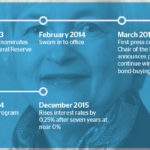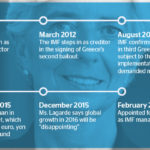3 women to lead global financial regulation
Who do we have in mind when referring to globally relevant women? Well, not about Beyoncé in music nor Angela Merkel in politics. We talk about the three women at the head of the three most relevant economic organizations in the world: The US Federal Reserve, the International Monetary Fund, and the Single Supervisory Mechanism of the European Central Bank. In this article, we take look at some of the career highlights of these leaders and how they have shaped their respective institutions, at this crucial time for the global economy.


Chronology of the milestones of Yellen as head of the Federal Reserve
Janet Yellen (70 years) – Chair of the US Federal Reserve
In 2014, Ms. Yellen became the first woman to lead the Federal Reserve, earning her the fourth position in Forbes’ The World's 100 Most Powerful Women. She stepped into office at a crucial time, right after the US Central Bank had started wrapping up the bond-buying program that it rolled out in the midst of the economic recession. With Yellen, the bond-buying program continued decreasing before stopping completely as of 2014.
Another one of her most prominent decisions was the interest rate raise announced in December 2015 - one fourth of a point, to a range between 0.25% and 0.50% after seven years between 0% and 0.25%. As Ms. Yellen herself explained during the corresponding press-conference in Washington, “This action marks the end of an extraordinary seven-year period during which the federal funds rate was held near zero to support the recovery of the economy from the worst financial crisis and recession since the Great Depression.”
Before being proposed to chair the Fed by Barack Obama, she served as vice chair of the Board of Governors of the Federal Reserve System and as president and chief executive officer of the Federal Reserve Bank of San Francisco. Under Bill Clinton’s presidency, she headed the Council of Economic Advisors. She is also is professor emeritus at the University of California at Berkeley.

Chronology of some of the key moments of the IMF under the direction of Lagarde
Christine Lagarde (60 years) – Managing Director of the International Monetary Fund (IMF)
Another one of the names that frequently pop up in Forbes’ rankings (sixth in 2015), was just appointed to serve a second term at the International Monetary Fund (IMF). Lagarde took office as head of the fund in 2011, in the midst of a global recession, becoming the first woman ever to be elected managing director of the IMF.
One of Christine Lagarde’s warhorses has been to claim a more prominent role for emerging markets in a new partnership for growth, as she emphasized during a recent speech. In January, the IMF downgraded its forecast for global economic growth for the two next years: 3.4% from 3.6% for 2016 and 3.6% from the previously estimated 3.8% for 2017.
A lawyer by training, Ms. Lagarde’s political career started in June 2005, when she was appointed France’s Minister of Commerce and Industry. After a brief stint as Minister of Agriculture in June 2007, she became the first female minister of Economy and Finance in a G7 Country (France). She also served as Chair of the Ecofin council (a body made up of the ministers of economic and financial affairs of the EU).

Chronology of the most important decisions made by the SSM, with Nouy as president
Danièle Nouy (65 years) – Chair of the Supervisory Board of the Single Supervisory Mechanism (European Central Bank)
Maybe not as well-known as Ms. Lagarde and Ms. Yellen, but not by any less relevant for the international financial scene. From January 1st, 2014, through December 31st, 2018, Daniéle Nouy will be the Chair of the Supervisory Board at the European Central Bank, i.e. the body responsible for centralizing the regulation and supervision of the European banking system.
As Mario Draghi remarked in 2013 on the occasion of her appointment "Ms. Nouy brings almost 40 years of experience in banking supervision.” Indeed, she served as secretary general of the French Prudential Supervisory Authority (from 2010 to 2013) and as Chair of the Committee of European Banking Supervisors. She also worked at France’s Central Bank for 30 years.
In the SSM, her mission is not minor: To build a supervisory system for the largest banks of the Eurozone. In an interview held on February 10th, 2014, with the Financial Times soon after taking over, Ms. Nouy said that “the challenge of the SSM is to co-operate in the framework of a single system. And I believe this can be achieved.” On November 11th, 2015, she stressed the importance of the stress tests completed in 2014, as the starting point of the single European supervision.
In a recent interview with German magazine Süddeutsche Zeitung she stated that “have no doubt that now, with the European banking union, we are in a much better position than we were before. Due to the comprehensive assessment, a sort of health check for banks, the banks have raised a lot of capital, in some cases even more than they had to."